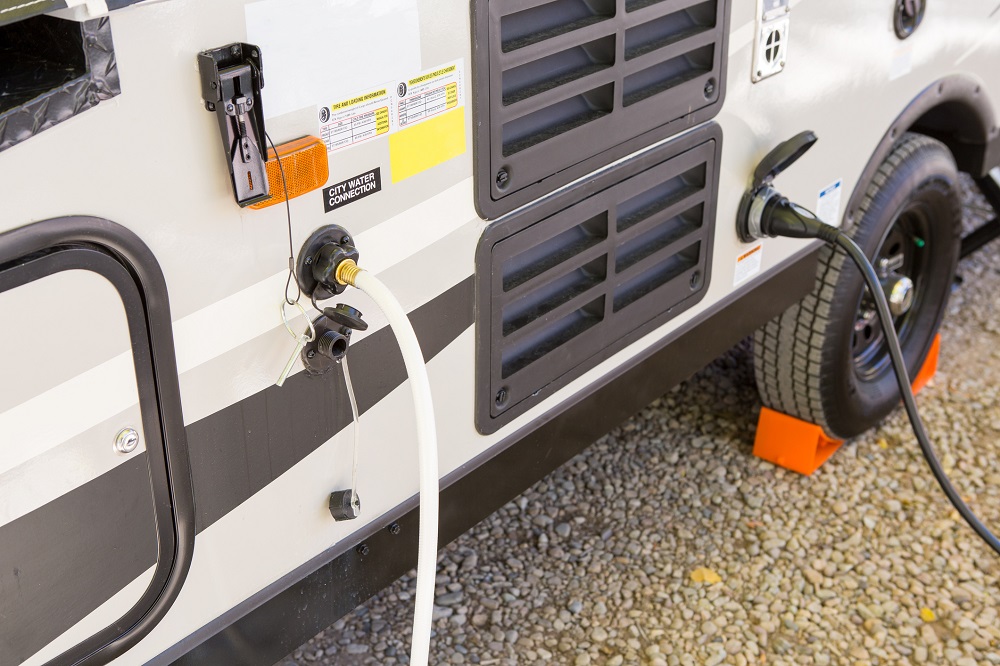 Hi, folks! This month we’ll talk about steps, hydraulics, inverters, winter survival, and what, if anything, to put in your black water tank. Remember to send your RVing questions to [email protected].
Hi, folks! This month we’ll talk about steps, hydraulics, inverters, winter survival, and what, if anything, to put in your black water tank. Remember to send your RVing questions to [email protected].
Hi, Mark,
While visiting an RV parts place, I heard a customer going on and on about the virtues of adding liquid Drano [or similar product] to the black tank. He stated that the stuff will clean out the tank, clean off the sensors, and clean and lube the waste drain valve. The idea sounded useful to me. I asked the parts counter guy about the idea. He did not want to answer my questions. Can you provide some insight as to the benefits and/or dangers of using this stuff in RV holding tanks? Thanx, Brent & Barb
Hi, Brent & Barb,
I would not recommend Drano for regular use in an RV holding tank. It is not designed for that kind of use and, over time, it might cause problems as it is a very strong caustic agent. OK, now I’m really going step WAAYYY out on that proverbial limb and talk about what to put in your holding tank. The reason that this is such a controversial topic is that absolutely everyone has a favorite toilet chemical. They are also certain that the inferior substitute you are using is nowhere near as cheap, effective, safe, or easy to use as their favorite. OK, I’m joking – a little. If you ever want to start a lively discussion around a campfire, ask what your neighbors are using for their holding tank! Personally, I rarely put any kind of chemical in my black water tank. I simply dump my tanks more often when it is hot to avoid serious odor problems. Many of the traditional toilet chemicals (blue stuff) are bad for the environment, tough on sewer treatment plants, expensive and only marginally effective at best. However, in recent years, a number of enzyme and bacterial tank treatments have appeared on the market. These products are designed to stimulate bacterial action and break down the waste and kill the odors. It’s kind of like having a miniature sewage treatment plant onboard. They carry an added benefit in being completely biodegradable and highly beneficial to RV park septic tanks and sewer treatment plants as well. I have used several different brands, and although they don’t control odors quite as well as the harsh blue stuff, they do an acceptable job, and also tend to liquefy the waste for easier dumping and flushing. Check out the shelf at your local RV parts store and read the labels to find enzyme or bacteria-based treatments. If you switch to a bio-friendly treatment after using that “blue stuff”, it may take a few flush/refill cycles before the old stuff stops killing or inhibiting the new stuff. It’s best to experiment until you find something that works for you, then stick with it. If you decide to use old fashioned toilet chemicals, please use them sparingly and avoid using any product with Formaldehyde (or any other “hyde”) as the active ingredient. Most home brew toilet treatments should also be viewed with a skeptical eye.
Mark,
Which brands of fifth wheels provide the best insulation for winter living. I live in mine full time and it cost a fortune to heat in the cold winters. I would appreciate any suggestions since I am shopping for a new one that will provide better winter living conditions. Thanks, LC
Hi, LC,
Many new RVs are available with a cold weather or polar package that include additional insulation, better windows, tank heaters, upgraded furnaces, and other cold weather equipment. If you are looking at a new RV, ask the dealer about cold weather options. I have also heard that the Canadian-made RVs tend to have better cold weather performance. Triple E, Glendale, Bruce and Bigfoot come to mind. Teton and Gulf Stream are American manufacturers that offer coaches with enhanced cold weather capabilities. There are probably many others as well, but you get the idea. It may also be possible to improve the cold-weather performance of your existing trailer by doing some simple mods. Adding window insulating film inside and additional insulation underneath the RV can make a big difference. If the underside of your RV is not already fully enclosed and insulated, it may be possible to add covers or spray-on insulation. If you are stationary during the winter, skirting around the base of the RV will greatly improve its cold-weather performance by eliminating the wind tunnel effect under the rig.
Mark:
My Lunde hydraulic lift works great to lift trailer but won’t lower the trailer. Lunde went out of business in 2006. Any suggestions? Ronnie
Hi, Ronnie,
Any time you have an obsolete piece of equipment that has also been orphaned, it is very difficult to find repair parts or service. Lunde jacks were used on a lot of horse and stock trailers, so if you can locate a stock trailer dealer in your area, it may be worth a trip to ask them about service and repair parts. I would also suggest RV salvage yards as a possible parts source. I have a list of these yards on my website at www.marxrv.com/rvsalvage.htm. You may also try searching the internet for a repair or parts manual for your model. If you have service information, it may be possible to repair the unit. Best of luck in your search!
Hi, Mark,
We have an Odessa Overland motorhome and a couple of days ago the Sure Step stopped retracting when we are ready to travel. Any suggestions for a quick fix or can you tell us where the ‘mechanics’ of it are to reset it? Thanks, Ken
Hi, Ken,
The step unit on your RV is most likely a Kwikee step. SureStep is the product name of a motion-activated step light that attaches to your existing RV step. Parts and service are readily available for Kwikee steps, because there are literally millions of them in use. There is no reset button. The step controller is in a sealed plastic box attached to the underside of the step itself. If your step starts to act up, there are a few things you can try. First, make sure that the step is properly lubricated, and that it moves freely. The motor operates on a load-sensing circuit, so if the step is binding, the motor may shut off, thinking that the step has reached the end of travel position. It is easier to extend the step, so often the step will come out OK, but won’t go back in. There is also a 12V wire going to the control box that should be energized when the RV ignition switch is on. That tells the controller to retract the step, so if it is loose or broken, the step won’t retract when you start the engine. Finally, the door switch that senses whether or not the entry door is closed may be dirty or defective. Many step failures can be traced to these simple items. It is also common to see steps acting up if the ground strap from the step frame to the RV frame is loose or disconnected. If all that fails to get the step working again, it may need further diagnosis and repair. Check out https://bobsguides.com/step-motor.html for troubleshooting tips, and visit https://www.lci1.com/support-center/ for manuals and repair guides for most Kwickee step models.
Hi, Mark,
Where does one install a power inverter to run power to the back of the RV for the TVs while driving, or parked without hook-up, and we do not want to run the generator? Doug
Hi, Doug,
There are a couple of different routes to go. One is to purchase a portable inverter that is just big enough to run the TV and the VCR or DVD player and plug it into an available 12V outlet in the rear of the rig (there’s usually one where the TV is intended to be mounted). If no 12V outlet is available, it’s not too hard to add one. The best part of this method is that it’s inexpensive and simple. The downside is that the inverter is limited in how much power it can produce and will only run fairly small AC loads. The other route is to install a larger, permanently wired RV inverter. Most of these units are designed to wire into your RV’s electrical system and will provide power for multiple devices. They can be configured to supply AC power to most or all of the receptacles that are already in place in your rig. The only limit is how much battery power you have available and how big your wallet is. The larger, permanently installed units are definitely the most convenient and flexible setup. Do a quick search online for “RV Inverter,” and you’ll turn up a number of sources and how-to articles.
 Founded in 1978, the Escapees RV Club provides a total support network that includes a wide variety of services and opportunities:
Founded in 1978, the Escapees RV Club provides a total support network that includes a wide variety of services and opportunities:
- Mail Service- Escapees offers the largest private mail service in the country. Members are able to personalize their mail delivery with multiple options. Custom sorting options, delivery schedule and even mail scanning. We make it easy!
- Mapping Tool- Plug in your starting point and destination, and let us do the rest! Our mapping tool will show you discount parks along your route, as well as trusted commercial members and endorsed vendors to help you with all of your needs along the way.
- Education- From our annual Escapades to our discussion forum, we help you connect with fellow RVers to share experience and knowledge. For the hands-on learner, RVers’ Boot Camp is a great way to learn about RV operation, safety and maintenance. Our award-winning magazine is also a great resource for peer-to-peer advice from fellow RVers and industry experts.
- Community- When you see an Escapees sticker on a rig, you know you’ve found a friend. Escapees hosts a variety of events throughout the year, including convergences, excursions, chapter rallies and Escapade. Each of these offers the opportunity to connect with other RVers and make new friends.
A complete listing of all Escapees events and a comprehensive list of member benefits are found at www.escapees.com





Anonymous
A very informative article,thankyou.